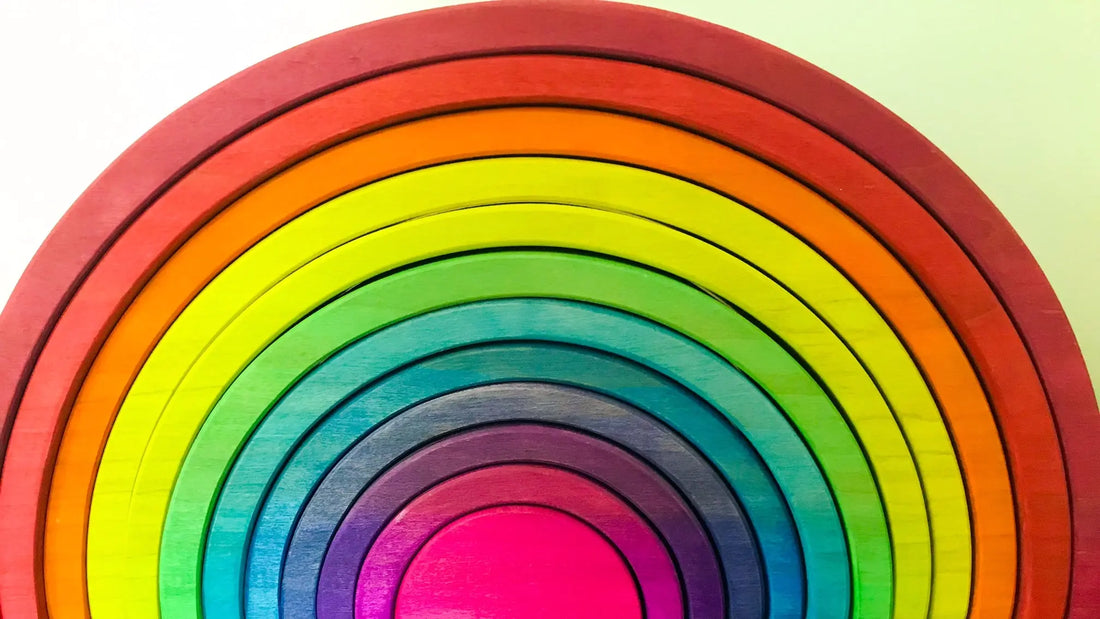
Do you rotate toys? Toy rotation means making a limited number of toys accessible to children at a particular time, with the remainder being stored elsewhere. Rotating toys can keep play spaces feeling fresh and interesting to children, and can nurture independent play. For a young child, rediscovering an old toy that they have not seen in a while can be just as exciting as getting a new one.
In our house, we never rotate all of our toys at once. By keeping out some toys and rotating a small selection, we can nurture our children’s ability to play and learn independently in the short- and long-term. Putting away toys not being used, and bringing out other toys, helps us to create novelty and thus nurtures independent play in the short-term.
Keeping out some old favorites encourages long-term independent play skills, as well as creativity and problem solving. It is important to support a child’s comfort with both boredom and familiarity. Getting a completely refreshed play space each week can make it harder for children to think of new ways to play with old things. There is so much creativity that children can build by repeatedly playing with the same toys.
Wondering which things to put away and which to keep out? Here’s what works for us:

We keep out:
• open-ended toys, such as blocks, Magnatiles, play silks, etc.
• favorite toys
• toys the children currently are in to (if they are taking a toy out frequently, no need to put it away)
• toys related to special interests: some children have a special passion (like trains or bunnies or trucks) and there is no need to put these preferred items away
• toys that reflect current life events; we keep out things related to what the children are doing in school, trips we’re going on, the current season or holidays
And we put away:
• toys the kids just aren’t using frequently or at all
• toys the children seem to have outgrown
• toys that are creating challenging scenarios

Sometimes a little structure as to which playthings to set out is helpful. In our house, it has helped me to think about our play space as though it were a preschool classroom and to consider and include different types of play that children learn from
Here are the categories I think about:
• Cognitive development: puzzles, games, stackers, shape-sorters, problem-solving toys that get children thinking
• Small-world play: small cars/trucks, peg dolls, animal figurines (things that allow children to set a scene and tell a story)
• Fine motor toys: stackers, geoboards, Legos, puzzles, posting toys (things that work a child’s finger muscles)
• Role-play toys: baby dolls, play food, doctor kit, etc.
• Manipulative toys: blocks, stackers, and magnetic tiles that children can use their whole hand to build, manipulate, and create with
• Sensory play: playdough, rice, beans, kinetic sand, etc.
• Literacy: books for everyone! You can add in alphabet toys and writing tools as children begin to show interest
• Gross motor toys: toys for throwing, jumping, climbing, dancing, and moving

Children might go through phases where they prefer a single or a couple types of play, or may grow to have preferences – that’s fine! I think of what is offered as a menu and let my kiddos pick what they want to do. Sometimes children can play with the same favored toy again and again for weeks or even longer. It is amazing how much they are learning through this repetition.
Infants may not really be ready for small-world play or role-play. It is fine to wait until they are ready. When you observe some early imaginative play (like pretending to feed a soft toy or talking on a pretend phone), you can introduce some of these things.
We do not keep all of our playthings in our playroom (sensory play and art happen in our kitchen). You can rotate toys whether or not you have a dedicated playroom. Children can learn through play in shared family spaces and bedrooms too.
Most good toys nurture multiple areas of development. Many of our toys are open-ended and can be used for many different purposes (for example, blocks can be used for building or in imaginative play). A lot of those toys always stay out in our home, and are cherished for their versatility.
We hope this makes toy rotation a little more manageable for your family – and helps you find those cherished moments of independent play

